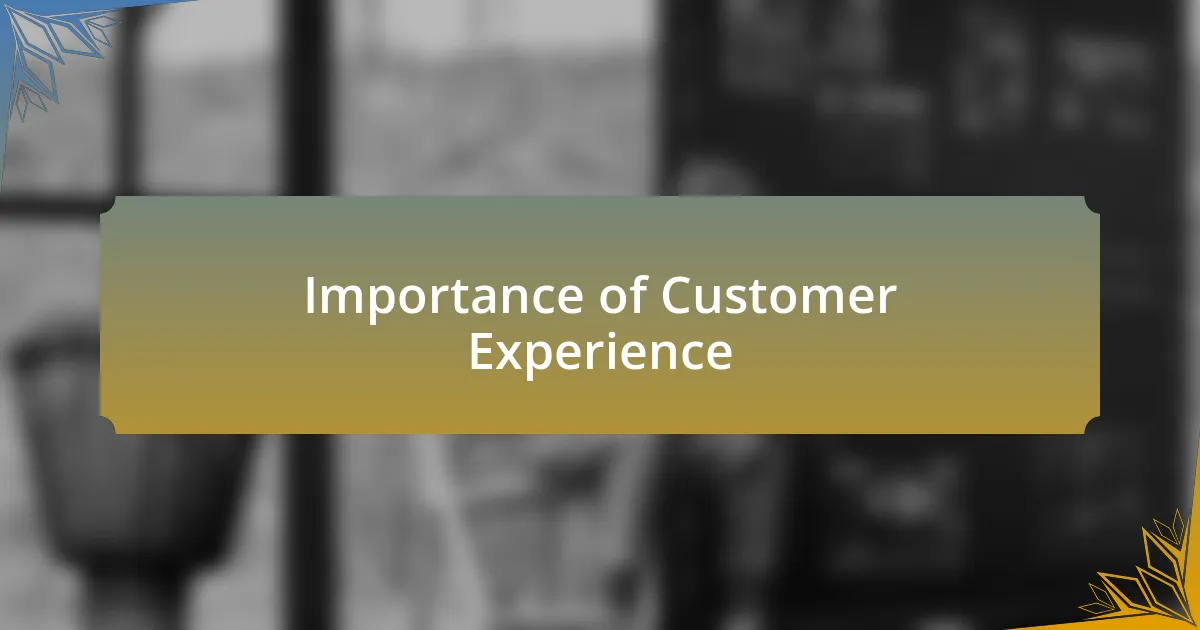Key takeaways:
- Customer service failures often stem from inadequate training, miscommunication, and lack of empathy, impacting overall customer satisfaction.
- A positive customer experience is crucial for loyalty, with businesses needing to respond effectively to service failures to maintain trust.
- Proactive communication, employee training in difficult situations, and implementing feedback loops are essential strategies for improving customer service.
- Understanding root causes of failures and fostering a culture of accountability can lead to significant improvements in customer interactions and business success.

Understanding Customer Service Failures
Customer service failures often occur when expectations don’t align with reality. I vividly remember a time when I ordered a special dessert for my birthday, only to have it forgotten entirely at the restaurant. It left me feeling disappointed and questioning whether my celebrations were valued.
These experiences highlight a crucial aspect of customer service: the emotional connection. When a business fails to deliver, it’s not just about the inconvenience; it’s about how that failure makes us feel. Have you ever been left on hold for hours, only to be transferred multiple times without resolution? It’s frustrating and can lead to feelings of being unheard, which can erode customer loyalty.
Furthermore, understanding why these failures happen can shed light on deeper systemic issues within a company. For instance, inadequate training or communication among staff can lead to mishaps. I once saw a team crumble during a busy day because no one knew how to handle a surge in complaints effectively. Recognizing and addressing these root causes can empower businesses to turn negative experiences into opportunities for growth and resilience.

Importance of Customer Experience
The importance of customer experience cannot be overstated; it’s the heartbeat of any business. Think about a time when you received exceptional service—maybe a friendly staff member went out of their way to help you. That warmth creates a lasting impression and makes you feel valued as a customer. I’ve walked out of stores just because the ambiance and service made me feel truly appreciated.
Moreover, a positive customer experience can be a strong differentiator in a crowded market. When you’re choosing between two similar products, how often do you consider the service you received? Personally, I always lean toward companies that prioritize customer satisfaction, even if it means paying a little extra. It’s a testament to how deeply I value my interactions and feelings during the purchase process.
On the flip side, neglecting customer experience can lead to dire consequences. I once chose a service based on price alone, only to be met with indifferent staff and a lack of support. That left such a sour taste that I vowed never to return. Isn’t it interesting how a single poor experience can overshadow countless positive ones? This reinforces the significance of prioritizing customer experience—it’s about making every interaction count.

Common Causes of Service Failures
Many service failures stem from inadequate training. I remember visiting a café where the barista struggled with basic menu items. Watching them fumble through simple orders made me wonder—how is it possible for someone to be unprepared in such a vibrant setting? I left feeling frustrated, realizing that proper training not only equips staff with necessary skills but also directly impacts customer satisfaction.
Miscommunication is another common pitfall that I’ve experienced firsthand. Once, I ordered a vegan dish at a restaurant, only to receive a plate with cheese. The server’s mix-up left me feeling uncomfortable and disappointed. It made me reflect on the importance of clear communication, both within the team and with customers. When expectations aren’t aligned, it’s the customers who bear the brunt of the confusion.
Finally, a lack of empathy often leads to service failures that can leave customers disillusioned. I recall a situation where I reached out to a customer support line, only to be met with a representative who was uninterested in my concerns. Their lack of understanding made me feel like just another number in the system. It’s a stark reminder that genuine care can create a world of difference; simply listening can turn a negative interaction into a positive outcome.

Impacts on Customer Loyalty
Experiencing poor customer service can swiftly erode loyalty. I once encountered a tech company that mismanaged my warranty claim. After multiple frustrating phone calls and an endless loop of automated messages, I felt a sinking disappointment. How could a brand I trusted let me down so completely? This disillusionment drove me to consider alternatives, highlighting how vital it is for businesses to honor commitments and maintain clear communication.
Loyalty is often tested when service failures occur, and how businesses respond makes all the difference. I remember a time when a hotel overbooked my stay. Instead of simply apologizing, the manager offered a complimentary upgrade and a heartfelt explanation. In that moment, their genuine care turned a sour situation into an experience that reinforced my allegiance to their brand. It made me wonder how many other customers could turn back to a business not just for the product, but for the way they’re treated in times of distress.
The ripple effects of a single service failure can reach far beyond the immediate transaction. After a particularly disheartening experience with a popular airline, I decided to share my story on social media, voicing my frustrations and feeling a strong sense of betrayal. This public airing of grievances not only deterred potential customers but also altered the brand’s perception in my network. It was a stark reminder that today’s customers are not just passive recipients; they advocate for their experiences, and loyalty can be fragile if not handled with care.

Lessons Learned from My Experiences
In my journey through customer service interactions, I’ve learned that follow-through is indispensable. For instance, a local restaurant messed up my order, but rather than brushing it off, the waiter took immediate responsibility. His sincere apology and quick resolution left me impressed; I left a positive review that day. It made me realize how simple acts of accountability can strengthen a connection between the business and the customer.
I’ve also observed that how a company responds to complaints can turn a negative experience into a memorable one. There was a time when my gym misplaced my membership renewal. Instead of the expected bureaucratic response, the manager not only rectified the error but also offered me a free month as a gesture of goodwill. This openness surprised me and reinforced my desire to remain a loyal member. It made me ponder: how many times do we notice the small things that build trust and rapport?
Finally, I’ve come to appreciate the power of empathy in customer service. During a shopping trip, I encountered a sales representative who genuinely listened to my concerns about a product. Her willingness to understand my frustration transformed my experience; I felt valued and heard. In that moment, I had to ask myself—how often do we extend that same understanding to others? Each of these experiences has reaffirmed my belief that effective communication and emotional intelligence are vital in fostering lasting customer relationships.

Strategies for Improvement
One effective strategy for improvement lies in proactive communication. There was an instance when I ordered a product online that was delayed beyond the expected delivery date. Instead of waiting for me to contact them, the company’s customer service team sent an email explaining the situation, along with an apology and a revised timeline. This level of transparency not only eased my frustration but also bolstered my trust in their brand. I often wonder how many businesses miss opportunities for connection simply by failing to keep their customers in the loop.
Another crucial avenue for improvement is training employees to handle difficult situations gracefully. I recall visiting a retail store where the cashier was under pressure due to a long line and a system outage. Instead of showing visible frustration, she kept her calm and expertly managed expectations by explaining the hold-up to customers, offering small discounts for the inconvenience. Her composed demeanor transformed what could have been a tumultuous experience into one where customers felt valued and understood. Reflecting on this, I often ask myself: how empowered are our frontline teams to turn challenges into opportunities?
Finally, implementing feedback loops can be a game-changer. A nearby coffee shop routinely surveys its patrons about their experiences, not just about the drinks but also about the ambiance and service. One day, I noticed they had made changes based on customer input, like adding more seating and improving the Wi-Fi. This responsiveness demonstrates a commitment to continuous improvement, and it makes me wonder—how often do businesses truly listen to their customers’ voices? Engaging in this dialogue fosters a sense of community and loyalty, ultimately enhancing the overall customer experience.

Implementing Changes for Success
Implementing changes for success often begins with understanding the root causes of past failures. I remember a hotel stay where my reservation had been lost due to a system glitch. Instead of merely apologizing, the management took tangible steps to revise their booking process, incorporating new software that minimized errors. Reflecting on this, I can’t help but ask: how often do businesses take these setbacks as opportunities rather than just inconveniences?
Another key aspect lies in fostering a culture of accountability among team members. I once participated in a team training session focused on customer service, where staff shared their experiences with mishandled situations. The openness in that room was palpable; it was a reminder that embracing vulnerability can lead to stronger relationships within the team. This makes me wonder—how many organizations encourage their staff to voice their challenges and learn from them collectively?
Lastly, celebrating small wins is essential in implementing change effectively. After a local restaurant revamped their menu based on customer feedback, they held a tasting event to showcase the improvements. I attended and witnessed the pride on the chefs’ faces as they interacted with patrons, receiving applause for their efforts. Isn’t it remarkable how acknowledging progress can reinvigorate staff and enhance customer connection?